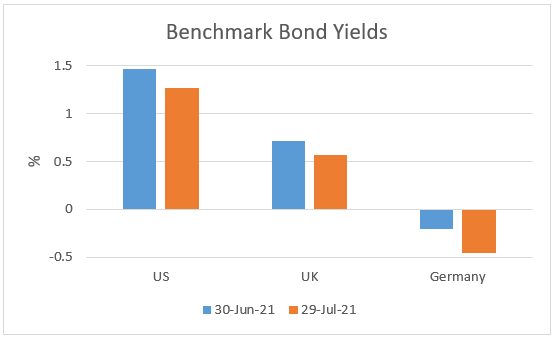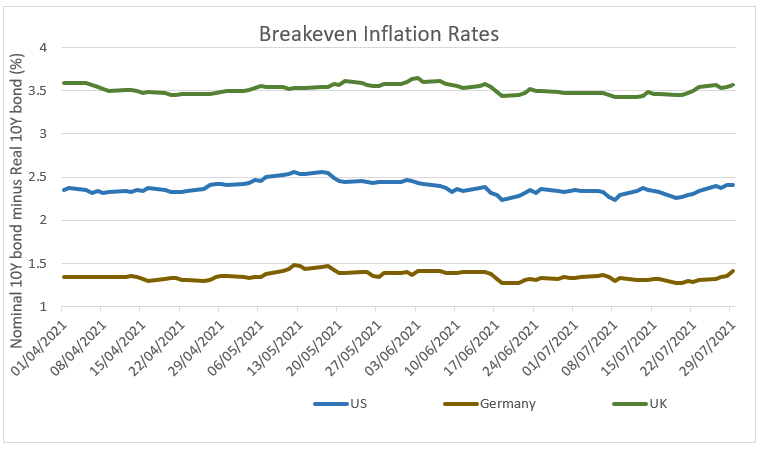How do we make sense of the recent rally in bond prices? Over the last few months markets have focused on the shape of the global recovery and the likely change of central bank policy to combat the revival of inflationary threats1 posed by:
1. Reducing output gaps
2. Commodity price rises (including Oil and gas)2
3. Disrupted supply chains
Considering these three challenges, equity market valuations seem to be aligned with the growth story. However, bond markets appear to have taken a different approach during the month of July when 10 Year Government bond yields fell (see Figure 1). The magnitude of yield changes is significant not only relative to the low level of absolute yields but also due to the fact that it occurred over a short period of time.
Figure 1:

Source: Bloomberg, as of 29th July, 2021.
You cannot invest directly in an index. Historical performance is not an indication of future performance and any investments may go down in value.
Why are we seeing this disconnect?
While financial markets have been heavily focused on inflation, the fixed income markets’ valuation framework does not corroborate this point. Inflation expectations embedded in fixed income securities have remained relatively stable since the end of the first quarter. This can be depicted by comparing the yield on a specific government nominal bond to its inflation-protected equivalent. This is called ‘breakeven inflation’ in bond jargon (see chart below). It shows the embedded average inflation expectation over the course of the next 10 years.
Figure 2:

Source: Bloomberg, as of 29th July, 2021.
You cannot invest directly in an index. Historical performance is not an indication of future performance and any investments may go down in value.
The key takeaway is that, using this valuation framework, inflation expectation has not materially changed over the course of the recent past as compared to the magnitude of the changes in nominal yields. This is true for the 3 selected bond markets. In other words the recent fall of nominal yields has been equally priced in real yield securities.
In conclusion the recent falls in bond yields cannot be attributed to a change of inflation expectations. The fall of real yields points to a revision of growth expectation, most likely due to a drop of daily vaccine doses administered in some countries combined with an increase of daily new cases in others. The question remains as to who is right, equity investors or bond investors?
Sources
1 US consumer price inflation increased by 5.4 per cent in the 12 months to June.
2 Commodities had their best quarterly performance in a decade (https://www.wisdomtree.eu/en-gb/-/media/eu-media-files/other-documents/research/commodity-monthly-monitor/2021,-d-,07_commodity-monthly-monitor.pdf?elqTrackId=93937f5db9fb4044a383441573cd545a&elq=db1b080e6ef1408d9babe9a870bb3e5b&elqaid=9935&elqat=1&elqCampaignId=5811)

